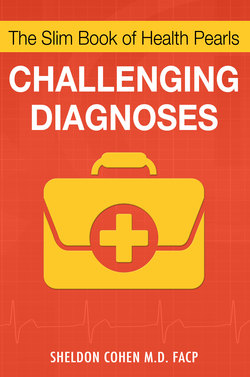Читать книгу The Slim Book of Health Pearls: Challenging Diagnoses - Sheldon Cohen - Страница 3
На сайте Литреса книга снята с продажи.
PROLOGUE
ОглавлениеIncorrect, delayed, or missed diagnoses have plagued physicians since the beginning of time. The result may be significant patient harm and medical resources wasted as the majority of all primary care physicians surveyed report that an average of five percent of their patients come under the category of “difficult to diagnose.” The more the experience of the physician, the less the diagnostic difficulty reported. As many as 20 percent of physicians report that inadequate knowledge was the main cognitive factor involved in failing to diagnose. Other factors include insufficient time to adequately reflect on diagnostically difficult patients, and inadequate time to acquire a careful medical history and perform a thorough physical examination; a situation which will only worsen as the primary care physician shortage is about to be compounded by an influx of patients due to the new Patient Protection and the Affordable Care Act, a bill signed into law to reform the countries healthcare (Obamacare).
This compounding of factors makes it more important than ever for patients to take the time to understand their own symptoms, assist in the zeroing in process of the diagnostic evaluation and collaborate fully with their physician in the sometime twists and turns leading to a final diagnosis. This intense exercise by both physician and patient alike will result in several different outcomes depending upon the complexity of the case:
•A correct diagnosis is established
•A single diagnosis is not established, but a differential diagnosis is. This is a number of plausible possibilities that each, in turn, require investigation to rule out or rule in
•An incorrect diagnosis has been established (misdiagnosis)
•No diagnosis has been made…no clue
•There is more than one diagnosis
So, as a prospective patient—and we all are at one time or another—it becomes more important than ever to be an assertive and collaborative patient, working in concert with the physician to arrive at, or on occasion, not arrive at a definite diagnosis.
Once this point has been reached, you as a patient are not finished. What the physician has done is carefully—you hope, made a list of all the diagnostic possibilities and ruled them out one by one until the final diagnosis is established. You need to be in on this process throughout, and when it has reached completion, or even during the process, you need to be constantly asking, “What else do we have to think about?” It is important that you have played a part in the process of elimination by being completely true with your medical facts, because incomplete or false statements can lead your physician down the wrong path, and ultimately lead to a wrong diagnosis.
This book will discuss illnesses difficult to diagnose. First among this category are autoimmune diseases, unrecognized as a medical entity until about sixty years ago. To better understand an autoimmune disease, it is essential to understand the concept of immunity, a subject for discussion now.
If you are blessed with sufficient body defenses to fight off invading infectious agents such as bacteria, viruses, fungi and parasites, you are said to have good immunity. Be thankful because there are some of us born with greatly diminished immune ability; or even born without any immunity. Anyone in this category is said to be immunocompromised. This threatening condition makes one extremely vulnerable to invasion by pathogens (an infectious agent that causes disease or illness to its host). The great majority of healthy persons with a well-functioning immune system will have no difficulty neutralizing invading pathogens before they can cause disease, but those whose immune system is compromised may fall victim to the invading pathogen’s effects—including death.
Again, in a book with the title CHALLENGING DIAGNOSES, why do I start with the subject of immunity? Because, as it turns out, most challenging diagnoses patients—the bane of primary care physicians and patients—are those who have developed an illness brought about by a malfunctioning immune system. So, if the readers are to have any hope of understanding what may be ailing them, then they must have a basic understanding of the mechanism that is causing their condition and their physician’s frustration in making what is often a very difficult diagnosis to establish. That is why this book must start with a treatise on the immune system
An understanding about the mechanism involved in the etiology of a puzzling illness, and often a chronic one at that, is crucial for any patient to be able to understand, accept and learn to live within its context. And I stress again: in the treatment of these unusual diseases, there is nothing more important than an educated patient working in collaboration with a dedicated physician. It can be a partnership guaranteeing the best possible result.
